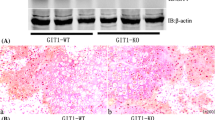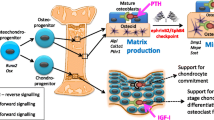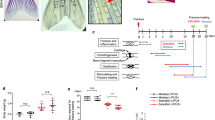Abstract
To identify the repertoire of ephrin genes that might regulate endochondral bone fracture repair, we examined changes in ephrin ligand and receptor (Eph) gene expression in fracture callus tissues during bone fracture healing. Ephrin and Eph proteins were then localized in the fracture callus tissues present when changes in gene expression were observed. Ephrin gene expression was widespread in fracture tissues, but the repertoire of ephrin genes with significant changes in expression that might suggest a regulatory role in fracture callus development was restricted to the ephrin A family members Epha4, Epha5 and the ephrin B family member Efnb1. After 3 weeks of healing, Epha4 fracture expression was downregulated from 1.3- to 0.8-fold and Epha5 fracture expression was upregulated from 1.2- to 1.5-fold of intact contralateral femur expression, respectively. Efnb1 expression was downregulated from 1.5- to 1.2-fold after 2 weeks post-fracture. These ephrin proteins were localized to fracture callus prehypertrophic chondrocytes and osteoblasts, as well as to the periosteum and fibrous tissues. The observed positive correlation between mRNA levels of EfnB1 with Col10 and Epha5 with Bglap, together with colocalized expression with their respective proteins, suggest that EfnB1 is a positive mediator of prehypertrophic chondrocyte development and that Epha5 contributes to osteoblast-mediated mineralization of fracture callus. In contrast, mRNA levels of Epha4 and Efnb1 correlated negatively with Bglap, thus suggesting a negative role for these two ephrin family members in mature osteoblast functions. Given the number of family members and widespread expression of the ephrins, a characterization of changes in ephrin gene expression provides a basis for identifying ephrin family members that might regulate the molecular pathways of bone fracture repair. This approach suggests that a highly restricted repertoire of ephrins, EfnB1 and EphA5, are the major mediators of fracture callus cartilage hypertrophy and ossification, respectively, and proposes candidates for additional functional study and eventual therapeutic application.



Similar content being viewed by others
References
Allan EH, Hausler KD, Wei T, Gooi JH, Quinn JM, Crimeen-Irwin B, Pompolo S, Sims NA, Gillespie MT, Onyia JE, Martin TJ (2008) EphrinB2 regulation by PTH and PTHrP revealed by molecular profiling in differentiating osteoblasts. J Bone Miner Res 23(8):1170–1181. https://doi.org/10.1359/jbmr.080324
Arthur A, Zannettino A, Panagopoulos R, Koblar SA, Sims NA, Stylianou C, Matsuo K, Gronthos S (2011) EphB/ephrin-B interactions mediate human MSC attachment, migration and osteochondral differentiation. Bone 48(3):533–542. https://doi.org/10.1016/j.bone.2010.10.180
Arthur A, Panagopoulos RA, Cooper L, Menicanin D, Parkinson IH, Codrington JD, Vandyke K, Zannettino AC, Koblar SA, Sims NA, Matsuo K, Gronthos S (2013) EphB4 enhances the process of endochondral ossification and inhibits remodeling during bone fracture repair. J Bone Miner Res 28(4):926–935. https://doi.org/10.1002/jbmr.1821
Arvanitis D, Davy A (2008) Eph/ephrin signaling: networks. Genes Dev 22(4):416–429. https://doi.org/10.1101/gad.1630408
Axelrad TW, Kakar S, Einhorn TA (2007) New technologies for the enhancement of skeletal repair. Injury 38(Suppl 1):S49–S62. https://doi.org/10.1016/j.injury.2007.02.010
Barnes GL, Kakar S, Vora S, Morgan EF, Gerstenfeld LC, Einhorn TA (2008) Stimulation of fracture-healing with systemic intermittent parathyroid hormone treatment. J Bone Joint Surg Am 90(Suppl 1):120–127. https://doi.org/10.2106/jbjs.g.01443
Benson MD, Opperman LA, Westerlund J, Fernandez CR, San Miguel S, Henkemeyer M, Chenaux G (2012) Ephrin-B stimulation of calvarial bone formation. Dev Dyn 241(12):1901–1910. https://doi.org/10.1002/dvdy.23874
Bolander ME (1992) Regulation of fracture repair by growth factors. Proc Soc Exp Biol Med 200(2):165–170
Cayuso J, Xu Q, Wilkinson DG (2015) Mechanisms of boundary formation by Eph receptor and ephrin signaling. Dev Biol 401(1):122–131. https://doi.org/10.1016/j.ydbio.2014.11.013
Cheng S, Zhao SL, Nelson B, Kesavan C, Qin X, Wergedal J, Mohan S, Xing W (2012) Targeted disruption of ephrin B1 in cells of myeloid lineage increases osteoclast differentiation and bone resorption in mice. PloS One 7(3):e32887. https://doi.org/10.1371/journal.pone.0032887
Cheng S, Kesavan C, Mohan S, Qin X, Alarcon CM, Wergedal J, Xing W (2013) Transgenic overexpression of ephrin b1 in bone cells promotes bone formation and an anabolic response to mechanical loading in mice. PloS One 8(7):e69051. https://doi.org/10.1371/journal.pone.0069051
Cho TJ, Gerstenfeld LC, Einhorn TA (2002) Differential temporal expression of members of the transforming growth factor beta superfamily during murine fracture healing. J Bone Miner Res 17(3):513–520. https://doi.org/10.1359/jbmr.2002.17.3.513
Compagni A, Logan M, Klein R, Adams RH (2003) Control of skeletal patterning by ephrinB1-EphB interactions. Dev Cell 5(2):217–230
Davy A, Aubin J, Soriano P (2004) Ephrin-B1 forward and reverse signaling are required during mouse development. Genes Dev 18(5):572–583. https://doi.org/10.1101/gad.1171704
Edwards CM, Mundy GR (2008) Eph receptors and ephrin signaling pathways: a role in bone homeostasis. Int J Med Sci 5(5):263–272
Fabes J, Anderson P, Brennan C, Bolsover S (2007) Regeneration-enhancing effects of EphA4 blocking peptide following corticospinal tract injury in adult rat spinal cord. Eur J Neurosci 26(9):2496–2505. https://doi.org/10.1111/j.1460-9568.2007.05859.x
Garcia-Ceca J, Alfaro D, Montero-Herradon S, Tobajas E, Munoz JJ, Zapata AG (2015) Eph/Ephrins-mediated thymocyte-thymic epithelial cell interactions control numerous processes of thymus biology. Front Immunol 6:333. https://doi.org/10.3389/fimmu.2015.00333
Hafner C, Meyer S, Hagen I, Becker B, Roesch A, Landthaler M, Vogt T (2005) Ephrin-B reverse signaling induces expression of wound healing associated genes in IEC-6 intestinal epithelial cells. World J Gastroenterol 11(29):4511–4518
Irie N, Takada Y, Watanabe Y, Matsuzaki Y, Naruse C, Asano M, Iwakura Y, Suda T, Matsuo K (2009) Bidirectional signaling through ephrinA2-EphA2 enhances osteoclastogenesis and suppresses osteoblastogenesis. J Biol Chem 284(21):14637–14644. https://doi.org/10.1074/jbc.M807598200
Jing X, Miyajima M, Sawada T, Chen Q, Iida K, Furushima K, Arai D, Chihara K, Sakaguchi K (2012) Crosstalk of humoral and cell-cell contact-mediated signals in postnatal body growth. Cell Rep 2(3):652–665. https://doi.org/10.1016/j.celrep.2012.08.021
Kania A, Klein R (2016) Mechanisms of ephrin-Eph signalling in development, physiology and disease. Nat Rev Mol Cell Biol 17(4):240–256. https://doi.org/10.1038/nrm.2015.16
Katoh M, Katoh M (2006) Comparative integromics on Eph family. Int J Oncol 28(5):1243–1247
Kwak H, Salvucci O, Weigert R, Martinez-Torrecuadrada JL, Henkemeyer M, Poulos MG, Butler JM, Tosato G (2016) Sinusoidal ephrin receptor EPHB4 controls hematopoietic progenitor cell mobilization from bone marrow. J Clin Invest 126(12):4554–4568. https://doi.org/10.1172/jci87848
Matsuo K (2010) Eph and ephrin interactions in bone. Adv Exp Med Biol 658:95–103. https://doi.org/10.1007/978-1-4419-1050-9_10
Matsuo K, Otaki N (2012) Bone cell interactions through Eph/ephrin: bone modeling, remodeling and associated diseases. Cell Adh Migr 6(2):148–156. https://doi.org/10.4161/cam.20888
Naik AA, Xie C, Zuscik MJ, Kingsley P, Schwarz EM, Awad H, Guldberg R, Drissi H, Puzas JE, Boyce B, Zhang X, O’Keefe RJ (2009) Reduced COX-2 expression in aged mice is associated with impaired fracture healing. J Bone Miner Res 24(2):251–264. https://doi.org/10.1359/jbmr.081002
Nunan R, Campbell J, Mori R, Pitulescu ME, Jiang WG, Harding KG, Adams RH, Nobes CD, Martin P (2015) Ephrin-Bs drive junctional downregulation and actin stress fiber disassembly to enable wound re-epithelialization. Cell Rep 13(7):1380–1395. https://doi.org/10.1016/j.celrep.2015.09.085
Popov C, Kohler J, Docheva D (2015) Activation of EphA4 and EphB2 reverse signaling restores the age-associated reduction of self-renewal, migration, and actin turnover in human tendon stem/progenitor cells. Front Aging Neurosci 7:246. https://doi.org/10.3389/fnagi.2015.00246
Sawamiphak S, Seidel S, Essmann CL, Wilkinson GA, Pitulescu ME, Acker T, Acker-Palmer A (2010) Ephrin-B2 regulates VEGFR2 function in developmental and tumour angiogenesis. Nature 465(7297):487–491. https://doi.org/10.1038/nature08995
Schruefer R, Sulyok S, Schymeinsky J, Peters T, Scharffetter-Kochanek K, Walzog B (2006) The proangiogenic capacity of polymorphonuclear neutrophils delineated by microarray technique and by measurement of neovascularization in wounded skin of CD18-deficient mice. J Vasc Res 43(1):1–11. https://doi.org/10.1159/000088975
Sims NA (2010) EPHs and ephrins: Many pathways to regulate osteoblasts and osteoclasts. IBMS BoneKEy 7(9):304–313
Stiffel V, Amoui M, Sheng MH, Mohan S, Lau KH (2014) EphA4 receptor is a novel negative regulator of osteoclast activity. J Bone Miner Res 29(4):804–819. https://doi.org/10.1002/jbmr.2084
Takyar FM, Tonna S, Ho PW, Crimeen-Irwin B, Baker EK, Martin TJ, Sims NA (2013) EphrinB2/EphB4 inhibition in the osteoblast lineage modifies the anabolic response to parathyroid hormone. J Bone Miner Res 28(4):912–925. https://doi.org/10.1002/jbmr.1820
Taylor H, Campbell J, Nobes CD (2017) Ephs and ephrins. Curr Biol 27(3):R90–R95. https://doi.org/10.1016/j.cub.2017.01.003
Ting MC, Wu NL, Roybal PG, Sun J, Liu L, Yen Y, Maxson RE Jr (2009) EphA4 as an effector of Twist1 in the guidance of osteogenic precursor cells during calvarial bone growth and in craniosynostosis. Development 136(5):855–864. https://doi.org/10.1242/dev.028605
Tonna S, Takyar FM, Vrahnas C, Crimeen-Irwin B, Ho PW, Poulton IJ, Brennan HJ, McGregor NE, Allan EH, Nguyen H, Forwood MR, Tatarczuch L, Mackie EJ, Martin TJ, Sims NA (2014) EphrinB2 signaling in osteoblasts promotes bone mineralization by preventing apoptosis. FASEB J 28(10):4482–4496. https://doi.org/10.1096/fj.14-254300
Wang HU, Chen ZF, Anderson DJ (1998) Molecular distinction and angiogenic interaction between embryonic arteries and veins revealed by ephrin-B2 and its receptor Eph-B4. Cell 93(5):741–753
Wang Y, Nakayama M, Pitulescu ME, Schmidt TS, Bochenek ML, Sakakibara A, Adams S, Davy A, Deutsch U, Luthi U, Barberis A, Benjamin LE, Makinen T, Nobes CD, Adams RH (2010) Ephrin-B2 controls VEGF-induced angiogenesis and lymphangiogenesis. Nature 465(7297):483–486. https://doi.org/10.1038/nature09002
Wang Y, Menendez A, Fong C, ElAlieh HZ, Chang W, Bikle DD (2014) Ephrin B2/EphB4 mediates the actions of IGF-I signaling in regulating endochondral bone formation. J Bone Miner Res 29(8):1900–1913. https://doi.org/10.1002/jbmr.2196
Wang T, Zhang X, Bikle DD (2017) Osteogenic Differentiation of Periosteal Cells During Fracture Healing. J Cell Physiol 232(5):913–921. https://doi.org/10.1002/jcp.25641
Xing W, Kim J, Wergedal J, Chen ST, Mohan S (2010) Ephrin B1 regulates bone marrow stromal cell differentiation and bone formation by influencing TAZ transactivation via complex formation with NHERF1. Mol Cell Biol 30(3):711–721. https://doi.org/10.1128/mcb.00610-09
Yamada T, Yoshii T, Yasuda H, Okawa A, Sotome S (2016) Dexamethasone regulates EphA5, a potential inhibitory factor with osteogenic capability of human bone marrow stromal cells. Stem Cells Int. https://doi.org/10.1155/2016/1301608
Zhao C, Irie N, Takada Y, Shimoda K, Miyamoto T, Nishiwaki T, Suda T, Matsuo K (2006) Bidirectional ephrinB2-EphB4 signaling controls bone homeostasis. Cell Metab 4(2):111–121. https://doi.org/10.1016/j.cmet.2006.05.012
Acknowledgements
The authors thank Nancy Lowen for expert assistance with the immunohistochemistry. This work was supported by Merit Review Award # 5 I01 BX002519-04 (WX, CHR) from the United States (US) Department of Veterans Affairs Biomedical Research and Development Program. SM is the recipient of a Senior Research Career Scientist Award from the U.S. Department of Veterans Affairs. CHR is a Research Biologist at the Jerry L. Pettis Memorial Veterans Administration Medical Center, Loma Linda, CA. The contents do not represent the views of the U.S. Department of Veterans Affairs or the United States Government.
Author information
Authors and Affiliations
Corresponding author
Ethics declarations
Conflict of interest
The authors declare no conflict of interest.
Electronic supplementary material
Below is the link to the electronic supplementary material.
Online Resource 3
. Bone formation marker protein isotype control immunohistochemistry. COLX and BGLAP IgG isotype controls in fractured femur tissues harvested at 3 weeks (a) and 4 weeks (b), respectively. Insets are low-magnification images of the section. f, fracture; ob, osteoblasts; ocy, osteocytes. Scale bars = 200 um. (TIF 4320 KB)
Online Resource 4
. Expression of ephrin A and ephrin B proteins in unfractured femur tissues. EFN and EPH expression is localized by immunohistochemistry in the contralateral femur from each of the fracture tissues in Fig 3. EFNA2 in the bone marrow at 2 weeks (a). EFNB1 in the periosteum at 3 weeks (b). EPHA4 in the bone marrow and in the distal articular chondrocytes (center inset) at 4 weeks (c). EFNB2 in the metaphysis at 1 week (d). EPHA5 in the bone marrow at 4 weeks (e). EPHB2 in the periosteum at 3 weeks (f). Lower left insets are low-magnification images of the section. Lower right insets show the distal growth plate. ac, articular cartilage; bm, bone marrow; cb, cortical bone; gpc, growth plate chondrocytes; mk, megakaryocyte; ob, osteoblasts; p, periosteum. Scale bars = 100 um. (TIF 7760 KB)
Online Resource 5
. Ephrin isotype control immunohistochemistry. EFN and EPH IgG isotype controls in unfractured femur (a, c, e, f) and fractured femur (b, d, f, g) tissues harvested at 1 week (a, b), 2 weeks (c, d), 3 weeks (e, f) and 4 weeks (g, h). Insets are low-magnification images of the section. bm, bone marrow; f, fracture; mk, megakaryocyte; hc, hypertrophic chondrocytes; ob, osteoblasts; ocy, osteocytes; p, periosteum, phc, prehypertrophic chondrocytes. Scale bars = 100 um. (TIF 10268 KB)
Rights and permissions
About this article
Cite this article
Kaur, A., Xing, W., Mohan, S. et al. Changes in ephrin gene expression during bone healing identify a restricted repertoire of ephrins mediating fracture repair. Histochem Cell Biol 151, 43–55 (2019). https://doi.org/10.1007/s00418-018-1712-7
Accepted:
Published:
Issue Date:
DOI: https://doi.org/10.1007/s00418-018-1712-7




